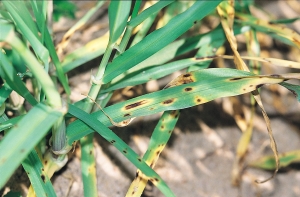
A long-awaited seasonal turnaround continues to deliver many New South Wales growers one of the better winter cropping season in years with medium to high yield potential in cereal crops.
It's also placed them on high alert for the development of cereal fungal diseases such as spot form net blotch, scald, powdery mildew and rust as they strive to maximise crop yield and gross margins.
A real challenge for growers and their agronomists lies in correctly identifying whether leaf yellowing or discolouration is related to disease, frost, herbicide phytotoxicity, physiological stress responses or agronomic constraints such as nitrogen (N) deficiency.
Incorrect identification can lead to unnecessary expenditure on fungicide applications which won't necessarily address the underlying issue according to New South Wales Department of Primary Industries (NSW DPI) Senior Plant Pathologist Steven Simpfendorfer.
"Our advice is, don't jump at shadows. We're in a very wet year but that doesn't mean that every issue in cereal crops is caused by disease," Dr Simpfendorfer said.
"Fungicides won't fix herbicide or frost damage and they won't correct nutrient deficiencies."

Get the diagnosis right
Physiological spotting that is not disease-related occurs every year, particularly in barley crops, and 2020 is proving no exception.
However, disease has clear patterns of distribution within paddocks, plants and even on individual leaves.
Despite this, Dr Simpfendorfer said accurate identification could be difficult and encouraged growers to seek a second opinion from a plant pathologist before embarking on a fungicide application.
"I was always taught to walk into a paddock and assume that the symptoms were not caused by disease. There are a lot of boxes to tick before you can convincingly attribute disease as the cause," he said.
"Earlier in the season there were a number of reports of leaf spotting which were actually due to contact herbicide, drift or inversion rather than disease.
"Similarly, we are starting to see some underlying nutrient issues, particularly in areas where N mineralisation hasn't been as high as hoped, which are expressing as mottling from the leaf tip backwards. Fungal diseases do not concentrate toward leaf tips.
"If growers are unsure, help is available simply by texting or emailing some good quality photos and relevant details such as variety and paddock history to NSW DPI pathologists in Tamworth. This can be a quick way to rule disease in or out before pulling the sprayer out of the shed.
"If symptoms appear consistent with disease, we can then confirm this through testing of submitted samples."
Submitted photos should be high quality and include images of:
- the affected paddock (showing the distribution of symptoms)
- affected individual plants (showing the distribution of symptoms through the plant canopy)
- affected individual leaves (showing the symptoms you are concerned about).






